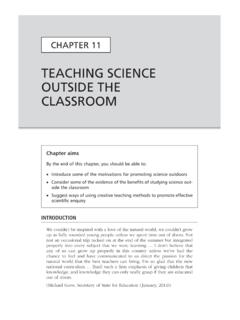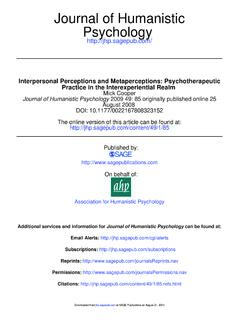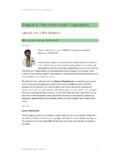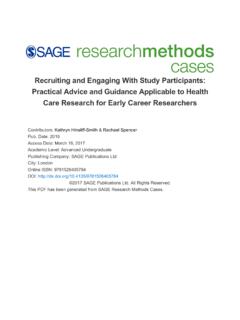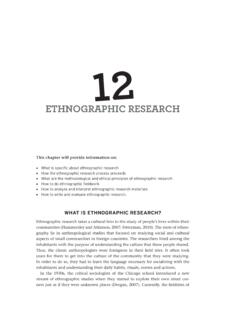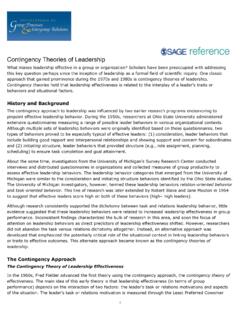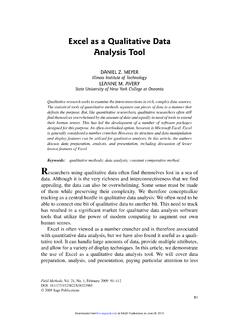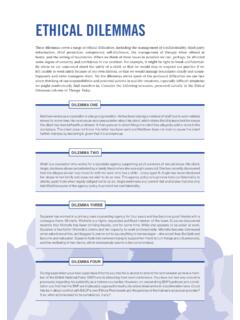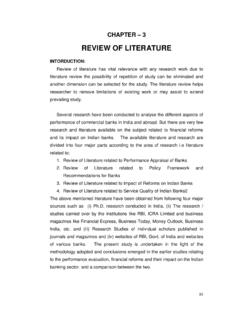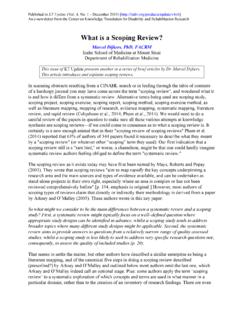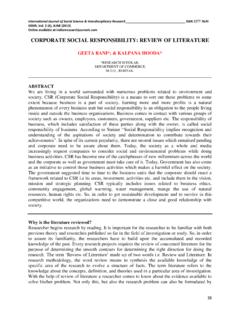Transcription of METHODOLOGY OF THE LITERATURE REVIEW
1 3 METHODOLOGY OF THE LITERATURE REVIEW Chapter 3 RoadmapBackground Concepts The CLR: A data collection tool The CLR as a method Considerations of mixed research techniquesNew Concepts Using multiple sections of a report A pathway to knowledge: METHODOLOGY The CLR as a METHODOLOGY The CLR meta-framework Introducing the Seven-Step ModelApplying Concepts Using the Seven-Step Model to inform primary research The Seven-Step Model as a cyclical 481/18/2016 3:30:36 PM49 METHODOLOGY of the LITERATURE REVIEW Background ConceptsThe CLR: A Data Collection ToolThe word data refers to a body of information.
2 This body of information can be extracted from many sources such as words, numbers, images, hyperlinks, audio, and video. Therefore, the information that the LITERATURE reviewer collects to inform a LITERATURE REVIEW represents data. Thus, it stands to reason that the LITERATURE REVIEW process can be viewed as a data collection tool that is, as a means of collecting a body of information per-tinent to a topic of interest. As a data collection tool, the LITERATURE REVIEW involves activities such as identi-fying, recording, understanding, meaning-making, and transmitting information.
3 Indeed, the LITERATURE REVIEW process is actualized through data collection. In its opti-mal form, the LITERATURE REVIEW represents a formal data collection process wherein information is gathered in a comprehensive CLR as a MethodIn the field of research, the term method represents the specific approaches and procedures that the researcher systematically utilizes that are manifested in the research design, sampling design, data collec-tion, data analysis, data interpretation, and so forth.
4 The LITERATURE REVIEW represents a method because the LITERATURE reviewer chooses from an array of strategies and procedures for identifying, recording, understanding, meaning-making, and transmitting information pertinent to a topic of interest. Moreover, as asserted by Onwuegbuzie, Leech, and Collins (2011), conducting a LITERATURE REVIEW is equivalent to conducting a research study, with the information that the LITERATURE reviewer collects representing the data.
5 In fact, as is the case for all studies, the litera-ture REVIEW involves the following four phases that we discussed in Chapter 1, namely, conceptualiza-tion, planning, implementation, and dissemination. As such, when the LITERATURE REVIEW stands alone ( , independent work), then the LITERATURE REVIEW represents a single research study that ends when the LITERATURE REVIEW process ends. In contrast, when the goal of the LITERATURE REVIEW is to inform primary research, then the LITERATURE REVIEW represents an embedded study.
6 Therefore, essentially, all studies that contain a REVIEW of the LITERATURE , however large or small, actually involve the conduct of two studies: a study of the previous knowledge ( , REVIEW of the LITERATURE ) and the primary research study conducted by the researcher(s) with the LITERATURE REVIEW study being embedded within the primary research study. With this in mind, as we stated in Chapter 1, research-ers should no longer view the LITERATURE REVIEW as one step of the many steps that underlie a research study; rather, the researcher should view the LITERATURE REVIEW as representing an embedded study.
7 Considerations of Mixed Research TechniquesAs you will see in the subsequent chapters, in its opti-mal form, the LITERATURE REVIEW not only represents a study; it also represents a mixed research study. In other words, the CLR is facilitated by using mixed research techniques that is, by collecting and ana-lyzing both quantitative and qualitative information within the same LITERATURE REVIEW . Traditionally, as noted in Chapter 1, many textbook authors give the impression that the LITERATURE REVIEW always varies with the type of primary study (Myth 9) and that it involves not only just summarizing the extant lit-erature (Myth 6) but also merely summarizing the findings of previous (related) studies.
8 Such myths falsely give the impression that only quantitative data should be summarized in quantitative research-based works and only qualitative data should be summa-rized in qualitative research-based works. As such, a LITERATURE reviewer who summarizes only quantitative research findings only will use quantitative data to inform the LITERATURE REVIEW . As discussed in Chapter 2, a LITERATURE reviewer prescribing to this myth likely might conduct what Gene Glass (1976) coined a meta-analysis, wherein the LITERATURE reviewer com-bines quantitative findings from as many available individual quantitative research studies as possible that address a set of related research hypotheses for the purpose of integrating the results.
9 Conversely, a LITERATURE reviewer who summarizes only qualita-tive research findings only will use qualitative data to inform the LITERATURE REVIEW . For instance, a liter-ature reviewer belonging to this camp might conduct 491/18/2016 3:30:36 PM50 Seven Steps to a Comprehensive LITERATURE Reviewwhat Sandelowski and Barroso (2006) refer to as a meta-synthesis, whereby the LITERATURE reviewer inte-grates qualitative research findings from selected qualitative research studies that represent interpretive syntheses of data addressing a set of related research questions for the purpose of integrating the results.
10 New ConceptsA LITERATURE REVIEW in its most comprehensive form includes a synthesis of quantitative findings stemming from quantitative research studies and qualitative findings stemming from qualitative research studies. Synthesizing both quantitative and qualitative findings within the same LITERATURE REVIEW automatically renders the LITERATURE REVIEW process as a mixed research study (Onwuegbuzie, Collins, et al., 2010). Using Multiple Sections of a ReportThe CLR as a mixed research study is enhanced by recognizing that meaning-making can occur from any aspect of a work ( , research article, book chapter, book), including the title, abstract, LITERATURE REVIEW section, theoretical or conceptual framework, purpose statement(s), research question(s)
